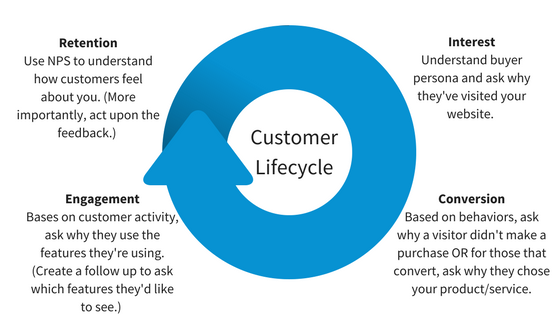How many surveys have you received in the past week? I just checked my inbox, and I’ve received seven total, which averages to one survey per day.

If you recently made a purchase or canceled a service, your survey probably goes one of two ways: “Why did you choose us?” or “Why are you leaving us?”
Imagine if you could engage with your customers on a more intimate level throughout their lifecycle while they’re engaged with your website or app. By asking questions throughout the customer journey, as opposed to just the beginning or end, you’re guaranteed to have a higher response rate opening yourself up to a wealth of knowledge about your customer's decision-making process. You would already know why they are choosing to cancel based on their previous interactions with you.
Although there is no “one size fits all” approach to collecting feedback from your customers in real-time, there are three factors that every company should consider before surveying their web visitors and customers. These factors include: determining when is the right time to ask a question, how often a user has been surveyed and your team’s ability to manage customer feedback in a timely manner.
How to Ask for Real-Time Customer Feedback
1. When is the right time to pop the question?
The magic question, when is the right time? We live in a world of survey fatigue. As mentioned previously, people expect to receive a survey via email when they sign up for a product or service or when they cancel. Engaging with them while they are interacting with your product or service is key.
When someone takes the time to visit your website or interact with your app, you should start thinking of all the potential times you can ask a question based on what these visitors are doing.
Examples of events include:
How many times a user has visited a specific page
When a user has visited the pricing page twice, for example, and hasn’t signed up, it might be time to ask them a question, like “did this page meet your expectations?”
Understanding why a user chose your product/service by asking who else they considered
When a user has chosen your product or service, you want to know why but instead of asking “why” in an email after they are disengaged, ask them immediately after they sign up and land in your app. Ask what other options they considered before choosing you.
How far along is the user in the onboarding process
At Qualaroo, the key step in getting our product setup is installing our Javascript code on your website. If a user has taken actions that indicate they are engaged in the product such as creating a survey but hasn’t installed the code, the appropriate question to ask is, “What is preventing you from installing the Qualaroo code on your website?”
All of these are examples of events that can trigger off a question to engage your user.
2. Respect the time of your customers. Don’t over-ask.
When you’re able to segment your audiences into specific groups based on their persona and behaviors, you immediately answer the standard questions found in long form surveys.
Don’t waste time asking questions you already know the answer to.
Even with the elimination of the wasted questions in long form surveys, you can still potentially bombard your users with too many questions. So how do you prevent this? Keep in mind a few things:
- Keep a survey to a minimum of 3-5 questions. After that, the response rate drops dramatically.
- Target appropriately. If you segment your audiences and ask them a question that is relevant to who they are or what they’re doing, you increase your chances of them responding.
You can target your audience by:
- Behaviors. Focus on those who are returning to your site, who have visited a number of pages. You can also target people who come directly to your site vs. those who come from a search engine.
- Browser type. Exclude visitors on specific browsers.
- Traffic sources. Focus on those who came directly to your site, or used specific search terms to come to your site.
- Identity. Segment by whether or not your user has logged into your app.
- Mobile traffic only. You can focus solely on those who come to your site from their mobile phone.
Taking the time to segment your audiences and develop the right questions will give you better statistical data to base decisions off of.
3. Create a continuous feedback loop.
The importance of real-time customer decision analysis has never been greater. Your customers are bombarded with advertisements from competitors and if you don’t take care of them someone else will. Taking immediate action on feedback from your customers can decrease churn, increase lifetime value, and create lasting impressions for your customers.
Often times, companies will launch surveys and then turn them off once they receive the results needed. If you’re constantly iterating on your product or service, then you have to implement a feedback loop that is constant. The answers you receive from users today can change over time to the exact same question.
Here are examples of questions you can ask at every stage of your customer’s lifecycle:

Create call-to-actions for every response you receive. For example, if you receive a detractor to your NPS survey, redirect that user to speak to someone from your customer success team immediately.
If you receive a promoter, while you have their attention, send them to a review site like G2 Crowd or have them like you on Facebook.
People make thousands of decisions every day, so don’t waste their time asking irrelevant questions -- ask questions in the moment that pertain the person you’re engaging with, and more importantly, take action immediately.








![‘How Did You Hear About Us’ Survey Options: All-In-One Guide [+ Examples]](https://blog.hubspot.com/hubfs/how%20did%20you%20hear%20about%20us_featured.jpg)
![How to Write an Apology Letter to Customers [12 Templates & Examples]](https://blog.hubspot.com/hubfs/apology%20letter%20to%20customer_featured.jpg)
